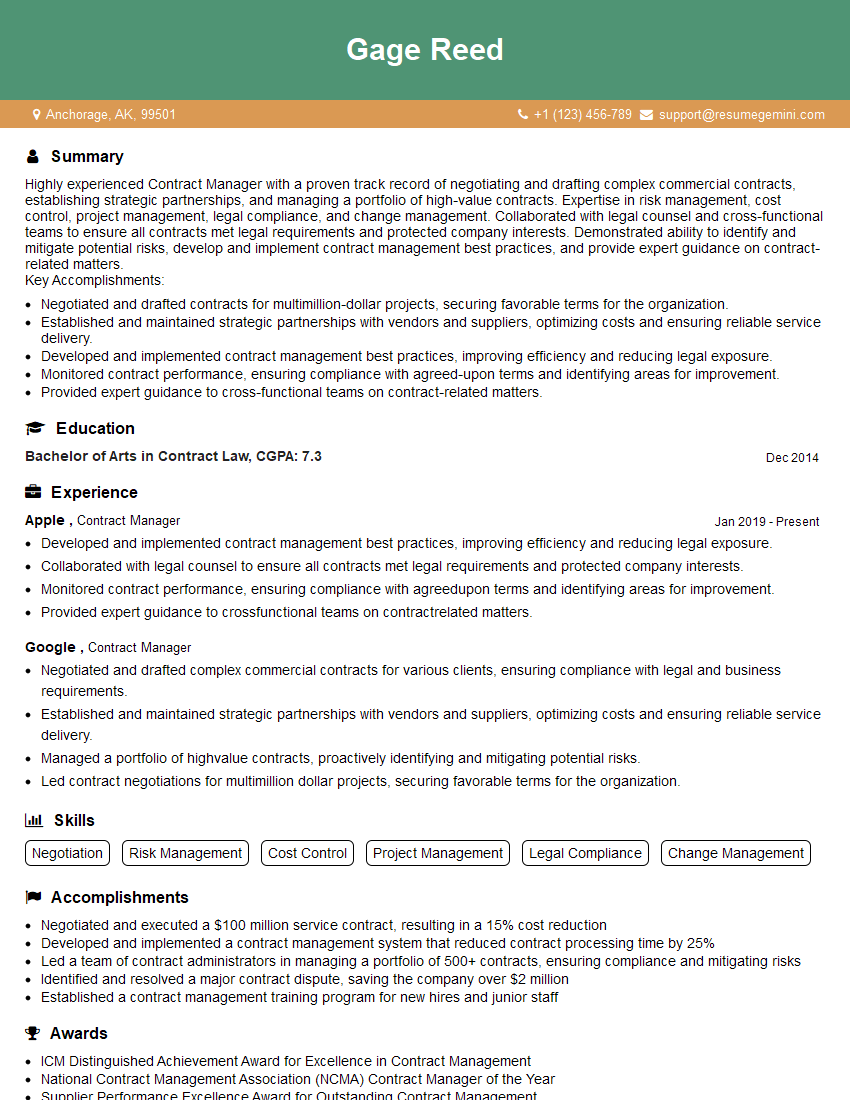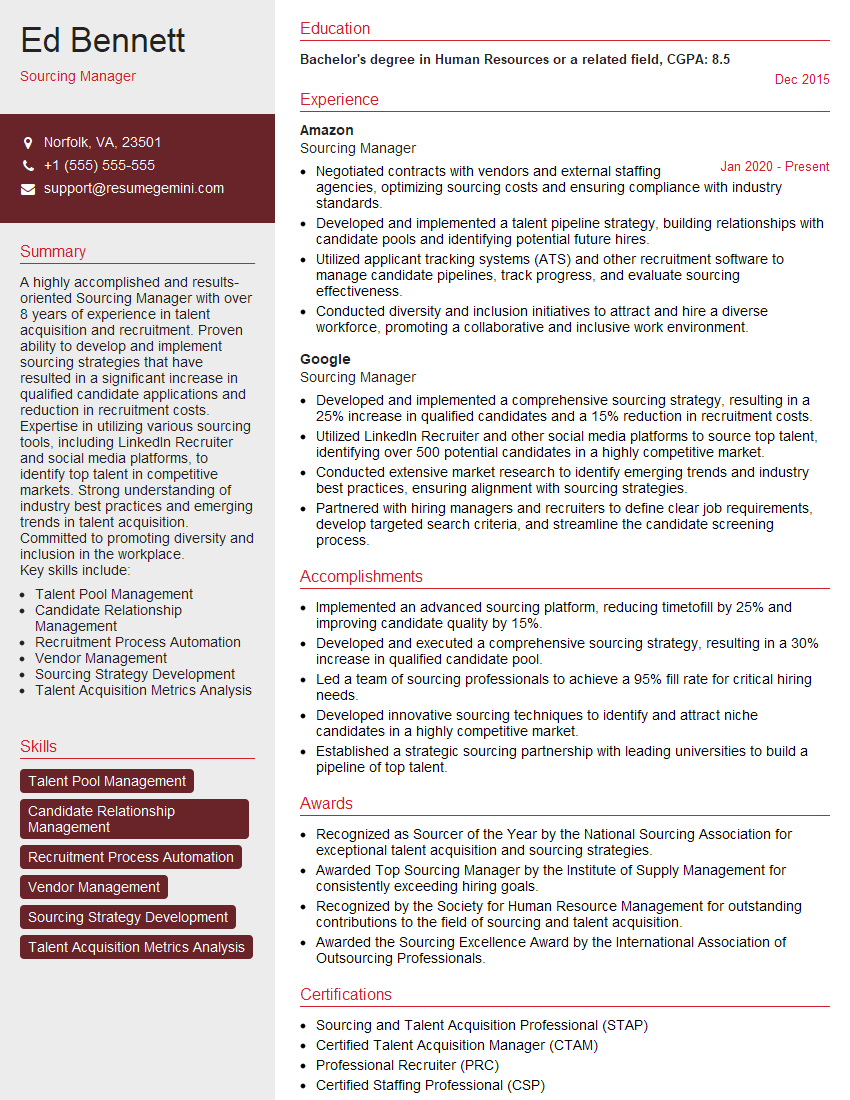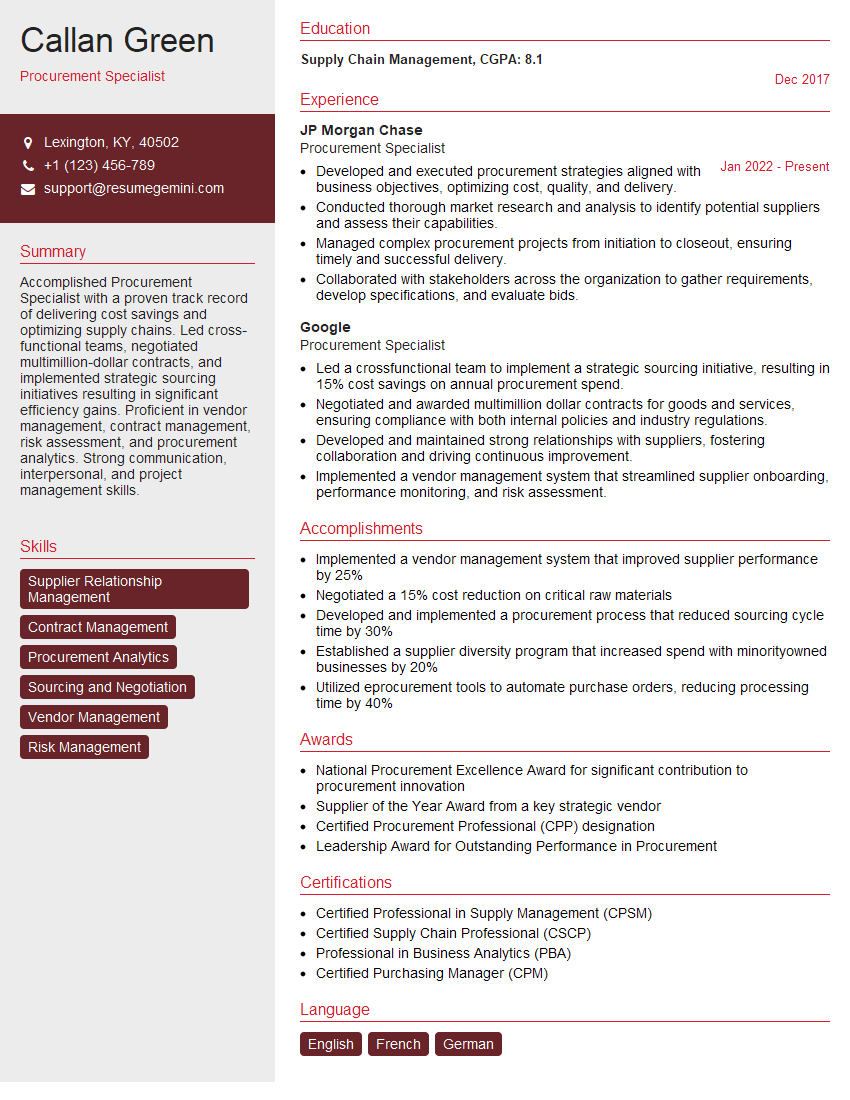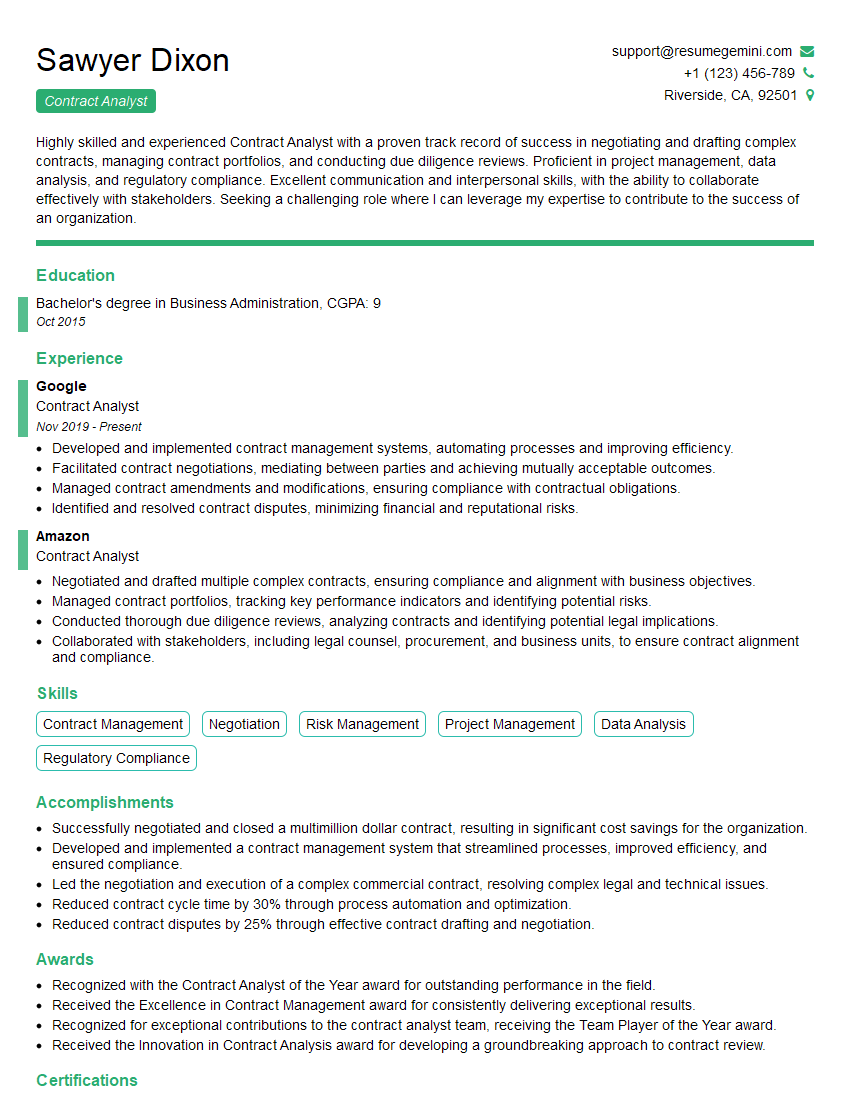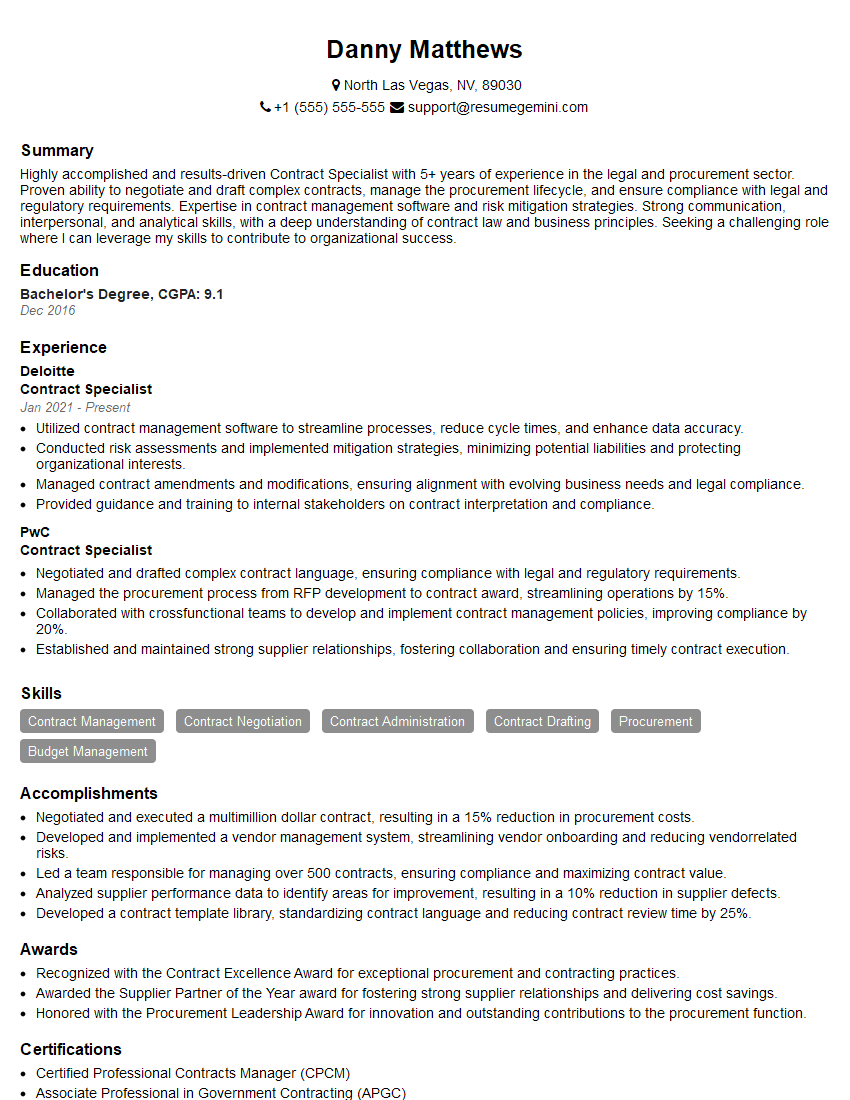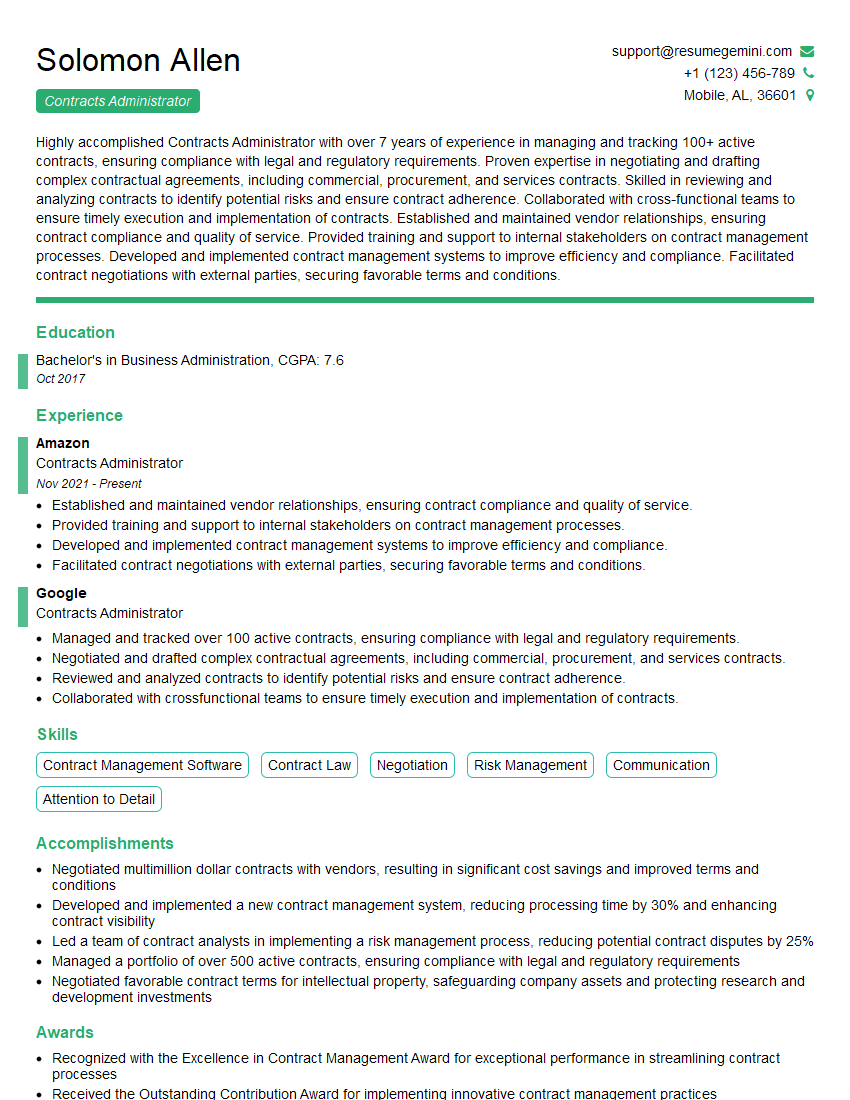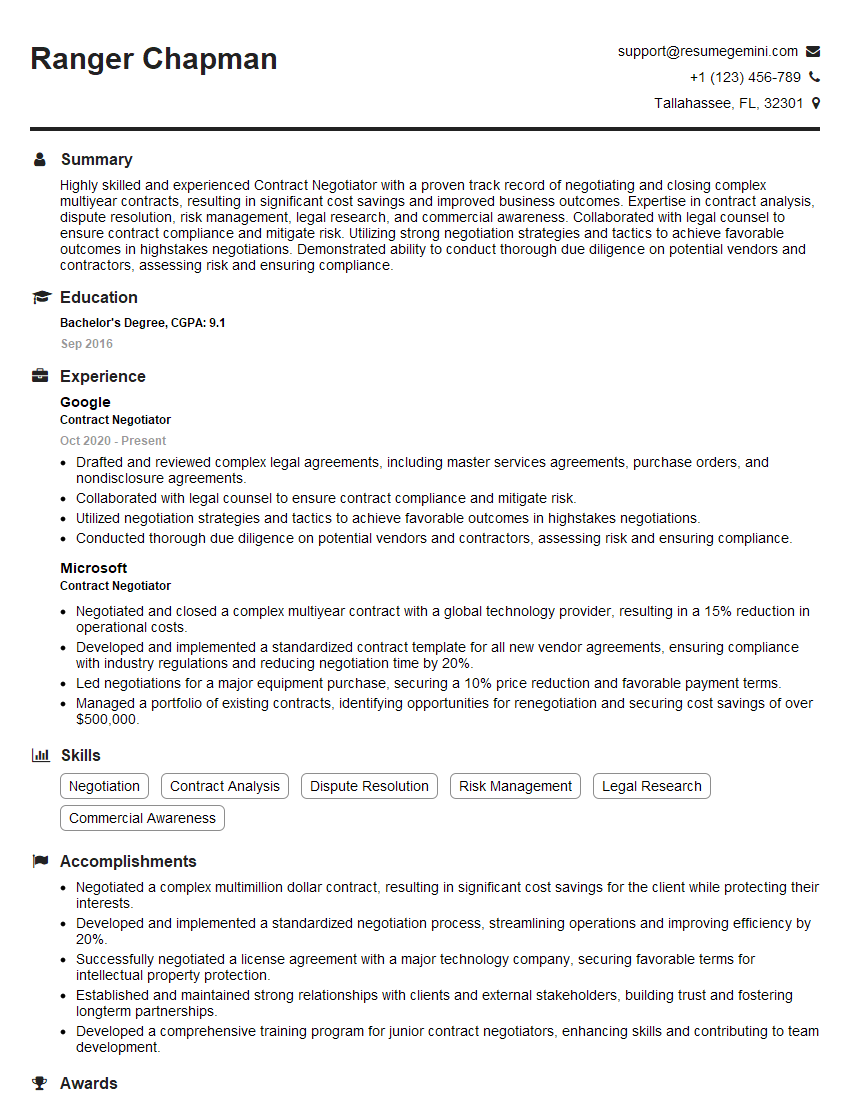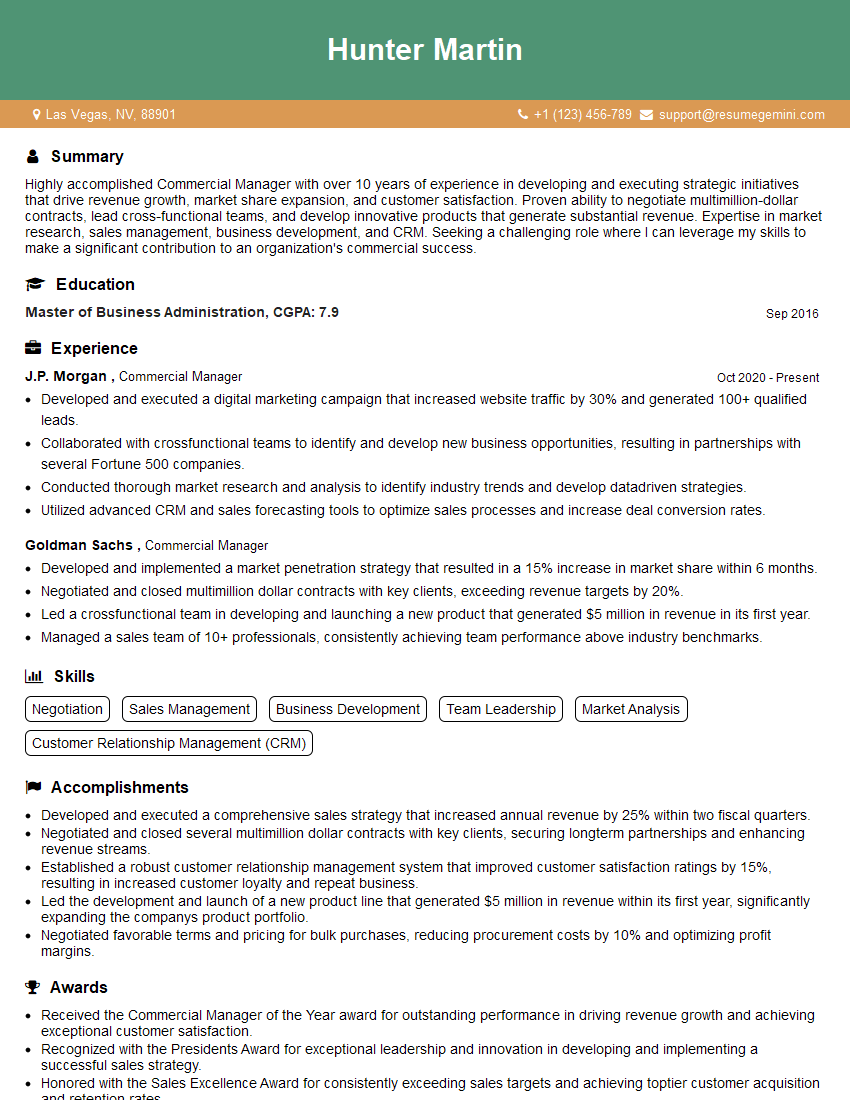Cracking a skill-specific interview, like one for Experience in negotiating and managing contracts, requires understanding the nuances of the role. In this blog, we present the questions you’re most likely to encounter, along with insights into how to answer them effectively. Let’s ensure you’re ready to make a strong impression.
Questions Asked in Experience in negotiating and managing contracts Interview
Q 1. Describe your experience negotiating complex contracts.
Negotiating complex contracts involves a strategic blend of preparation, communication, and tactical maneuvering. It’s not just about getting the best deal; it’s about securing a mutually beneficial agreement that protects all parties involved. My approach starts with a thorough understanding of my client’s needs and objectives, which I translate into specific, measurable contract goals. I then meticulously research the other party, analyzing their past dealings and understanding their potential motivations. This allows me to anticipate their negotiating points and formulate effective counter-arguments.
For instance, in negotiating a multi-million dollar software licensing agreement, I identified a hidden clause that favored the vendor on intellectual property rights. By meticulously researching similar agreements and employing industry best practices, I was able to successfully renegotiate this clause to reflect a more equitable distribution of IP rights, significantly mitigating potential future risks for my client. Throughout the negotiation process, I maintain clear, professional communication, building rapport while firmly advocating for my client’s interests. This approach ensures a win-win outcome while protecting against future disputes.
Q 2. What strategies do you use to identify potential risks in a contract?
Identifying potential risks in a contract requires a systematic approach, much like a detective investigating a crime scene. My strategy involves a multi-stage process. Firstly, I carefully review each clause, looking for ambiguities or loopholes that could be exploited. This includes paying close attention to termination clauses, liability limitations, and intellectual property rights. Secondly, I consider external factors such as market volatility, regulatory changes, and the financial stability of the other party. These factors can significantly impact the contract’s performance and longevity.
For example, in a construction contract, I would identify the risk of material price increases by including a clause that allows for price adjustments based on market fluctuations. Similarly, I’d analyze the financial stability of the contractor to mitigate the risk of project delays due to bankruptcy. Finally, I utilize risk assessment matrices to categorize and prioritize risks based on their likelihood and potential impact, enabling me to develop tailored mitigation strategies.
Q 3. Explain your process for reviewing and analyzing contract terms.
My contract review process is meticulous and thorough. It’s not just about reading the words; it’s about understanding the implications of each clause. I typically begin with a high-level overview to grasp the contract’s overall structure and purpose. Then I delve into a detailed analysis, clause by clause, ensuring I understand each term’s definition and implications. I pay particular attention to key provisions like payment terms, intellectual property rights, confidentiality obligations, and dispute resolution mechanisms. I cross-reference clauses to ensure consistency and identify any potential conflicts. Finally, I compare the contract terms to industry standards and best practices to ensure fairness and protection for my client.
I often use checklists and comparison matrices to ensure I don’t miss any crucial details. This methodical approach minimizes the risk of overlooking critical issues and ensures that all aspects of the contract are comprehensively evaluated before signing.
Q 4. How do you handle disagreements or disputes during contract negotiations?
Handling disagreements during contract negotiations requires diplomacy, strategic thinking, and a commitment to finding mutually acceptable solutions. My approach focuses on open communication and collaborative problem-solving. I begin by clearly articulating the point of contention, actively listening to the other party’s perspective, and seeking to understand their underlying concerns. I then explore alternative solutions, brainstorming options that address both parties’ interests. If a compromise isn’t readily achievable, I might propose mediation or arbitration, neutral third-party processes that can facilitate a resolution. The key is to remain professional, respectful, and focused on finding common ground.
In one instance, a dispute arose over the definition of ‘completion’ in a construction project. Through collaborative discussions, we agreed to define ‘completion’ based on a series of verifiable milestones, avoiding a potentially costly and time-consuming legal battle. This demonstrates the power of proactive communication and a willingness to compromise in achieving a satisfactory outcome.
Q 5. What is your experience with different types of contracts (e.g., NDA, SLA, MSA)?
My experience encompasses a wide range of contract types, including NDAs (Non-Disclosure Agreements), SLAs (Service Level Agreements), and MSAs (Master Service Agreements). I’m familiar with the specific nuances and legal requirements of each type. For example, NDAs require a precise definition of confidential information and the scope of confidentiality obligations. SLAs need to clearly define service levels, performance metrics, and remedies for non-compliance. MSAs provide a framework for governing multiple transactions between parties, requiring careful consideration of the overall relationship and its potential future evolutions.
I have successfully negotiated and managed hundreds of these contracts across diverse industries, ensuring they adequately address the specific needs and risks involved in each situation. This broad experience allows me to effectively navigate the complexities of different contractual relationships and secure optimal outcomes for my clients.
Q 6. Describe a situation where you had to renegotiate a contract.
In a recent project involving a technology licensing agreement, we initially agreed upon a fixed-fee payment structure. However, due to unforeseen market changes and increased development costs on our client’s side, the original terms became unsustainable. I initiated a renegotiation process by clearly explaining the changed circumstances and proposing alternative payment structures. This involved detailed financial analysis demonstrating the increased costs and their impact on project feasibility. Through collaborative discussions, we agreed on a revised payment schedule that incorporated incentives for milestone completion, ensuring a fair and viable solution for both parties. This ultimately prevented a project cancellation and preserved a valuable business partnership.
Q 7. How do you prioritize contract clauses based on business needs?
Prioritizing contract clauses based on business needs involves a strategic assessment of risks and opportunities. I begin by identifying the contract’s core objectives and the key elements essential for achieving those objectives. For example, in a technology licensing agreement, intellectual property rights and payment terms would be paramount. I then assign weights to each clause based on its importance to the overall business goals. Risk assessment plays a critical role, with clauses related to liability limitations and dispute resolution receiving higher priority given their potential impact on the client’s financial and operational stability. This weighted approach allows me to focus negotiation efforts on the most crucial clauses, maximizing the protection of client interests while balancing the needs for efficient contract execution.
Q 8. How familiar are you with contract law principles?
My familiarity with contract law principles is extensive. I possess a deep understanding of fundamental concepts such as offer and acceptance, consideration, capacity, legality, and the various types of contracts (e.g., express, implied, unilateral, bilateral). I’m also well-versed in the nuances of contract interpretation, including rules of construction and the impact of ambiguous language. My experience extends to understanding the legal ramifications of breach of contract, remedies available to aggrieved parties, and the processes involved in dispute resolution, including negotiation, mediation, arbitration, and litigation. I regularly consult legal counsel to ensure contracts are legally sound and compliant. For example, I recently navigated a complex contract negotiation involving intellectual property rights, requiring a detailed understanding of licensing agreements and copyright law to protect both our client and the vendor.
Q 9. How do you ensure compliance with all relevant laws and regulations in contracts?
Ensuring compliance with relevant laws and regulations is paramount in contract management. My approach involves a multi-faceted strategy. First, I conduct thorough due diligence before drafting or reviewing any contract, identifying all applicable laws and regulations (e.g., data privacy laws like GDPR, consumer protection laws, industry-specific regulations). Secondly, I incorporate explicit clauses into the contract to address these requirements. For instance, when dealing with international contracts, we explicitly address jurisdiction and applicable law. Thirdly, I work closely with legal counsel to review complex contracts, ensuring compliance and mitigating potential legal risks. Finally, we implement a system for ongoing monitoring to ensure continuing compliance throughout the contract lifecycle. This might involve periodic reviews or setting up alerts for relevant legal updates. For example, we recently had to amend several contracts to comply with new data privacy legislation, proactively addressing potential non-compliance.
Q 10. What software or tools do you utilize for contract management?
I utilize a range of software and tools for efficient contract management. These include contract lifecycle management (CLM) platforms such as Agiloft or Conga Contracts, which streamline the entire contract process from creation and negotiation to execution, performance monitoring, and renewal. These platforms offer features like version control, automated workflows, central repositories, and reporting dashboards. In addition, I leverage document management systems like SharePoint or Dropbox for secure storage and collaboration. For efficient communication and tracking, I utilize project management tools like Asana or Monday.com to keep everything organized and transparent. The specific tools used often depend on the size and complexity of the contract and the client’s preferred systems. The key is to select tools that support collaboration, automate repetitive tasks and provide robust data analysis capabilities.
Q 11. Explain your approach to managing contract lifecycle stages.
My approach to managing the contract lifecycle involves a structured, phased methodology. It begins with pre-contract planning where we clearly define objectives, identify stakeholders and assess risks. The drafting and negotiation phase follows, where we ensure the contract accurately reflects the agreed-upon terms and aligns with legal requirements. This involves meticulous review, redlining, and revisions. The execution and approval stage involves obtaining necessary approvals and executing the final version. The performance management phase is critical, involving regular monitoring, performance tracking, and communication with both parties. Finally, the renewal or termination phase involves evaluating the contract’s performance, negotiating renewals, or managing a proper termination. Each stage is meticulously documented, and clear communication channels are maintained throughout the lifecycle, avoiding misunderstandings and streamlining the process. I often use project management tools to track progress, deadlines and responsibilities across each stage.
Q 12. How do you balance the interests of both parties during negotiations?
Balancing the interests of both parties during negotiations is crucial. My approach is based on principled negotiation. This means focusing on the underlying interests of each party rather than just their stated positions. I strive to create a collaborative environment where both sides feel heard and respected. I actively listen, ask clarifying questions, and present options that address the needs of all stakeholders. I approach negotiations with a win-win mentality, aiming for a solution that is mutually beneficial and sustainable. Sometimes compromise is necessary, and I’m adept at finding creative solutions that address concerns without sacrificing critical objectives. For example, in a recent negotiation, we resolved a pricing dispute by adjusting payment terms instead of altering the overall price, satisfying both the client’s budget constraints and our profit margin.
Q 13. What is your understanding of risk mitigation in contract management?
Risk mitigation is a core element of my contract management approach. I identify potential risks at each stage of the contract lifecycle, including legal, financial, and operational risks. This involves a comprehensive risk assessment, considering factors such as the counterparty’s financial stability, the complexity of the project, and the potential for unforeseen circumstances. I then develop mitigation strategies to address these risks. These strategies can include insurance, indemnities, warranties, escrow arrangements, or detailed performance metrics with clear consequences for non-compliance. Regular reviews and monitoring also aid in identifying and addressing emerging risks proactively. For instance, in a recent project, we included force majeure clauses to address potential disruptions due to unforeseen events like pandemics or natural disasters, effectively minimizing the impact on both parties.
Q 14. Describe your process for tracking and reporting contract performance.
Tracking and reporting contract performance is done through a combination of methods. Firstly, we establish key performance indicators (KPIs) early in the contract lifecycle, aligning them with the contract’s objectives. These KPIs are regularly monitored using the CLM system and project management tools. Secondly, we establish regular reporting schedules, providing both parties with transparent updates on progress and performance. This information helps both parties identify any potential issues early on and take corrective actions. Finally, we use data analytics to identify trends and patterns in contract performance, enabling proactive adjustments and future improvements. We create comprehensive reports summarizing key metrics, highlighting any areas of concern or success. These reports are shared with relevant stakeholders and used to inform future contract negotiations and management strategies. The reporting frequency depends on the contract’s complexity and criticality; some might require weekly reports, while others are suitable for monthly updates.
Q 15. How do you manage multiple contracts simultaneously?
Managing multiple contracts effectively requires a structured approach. Think of it like managing multiple projects simultaneously – you need a robust system to keep everything organized and on track. I utilize a combination of tools and techniques to achieve this. Firstly, I employ a centralized contract management system, often a dedicated software solution, that allows me to track key details, deadlines, and performance metrics for each contract. This system acts as a single source of truth, preventing information silos. Secondly, I prioritize contracts based on their criticality and urgency, using a prioritization matrix that considers factors such as financial impact, risk level, and contractual deadlines. Finally, I regularly review my workload and delegate tasks where appropriate, ensuring efficient resource allocation. For instance, I might delegate routine monitoring tasks to a junior team member while I focus on high-stakes negotiations or complex contract amendments. This allows me to handle a large volume of contracts without sacrificing quality.
Career Expert Tips:
- Ace those interviews! Prepare effectively by reviewing the Top 50 Most Common Interview Questions on ResumeGemini.
- Navigate your job search with confidence! Explore a wide range of Career Tips on ResumeGemini. Learn about common challenges and recommendations to overcome them.
- Craft the perfect resume! Master the Art of Resume Writing with ResumeGemini’s guide. Showcase your unique qualifications and achievements effectively.
- Don’t miss out on holiday savings! Build your dream resume with ResumeGemini’s ATS optimized templates.
Q 16. How do you handle contract amendments and modifications?
Contract amendments and modifications are handled with meticulous care, ensuring legal compliance and protecting the interests of all parties involved. The process begins with a thorough review of the original contract and the proposed changes. I carefully analyze the impact of the modifications on the overall contract, identifying any potential conflicts or inconsistencies. Once the changes are understood, I draft a formal amendment document, clearly outlining the revised terms and conditions. This document is reviewed by all relevant stakeholders, including legal counsel if necessary. Finally, all parties sign the amendment, and it’s officially incorporated into the original contract. For example, in a software licensing agreement, an amendment might be needed to extend the term or modify the scope of services. Each amendment is meticulously documented and stored with the original contract in our centralized system to maintain a complete and auditable record.
Q 17. Explain your experience with contract database management.
My experience with contract database management is extensive. I’ve worked with various systems, from simple spreadsheets to sophisticated contract lifecycle management (CLM) software. I’m proficient in using these systems to store, retrieve, and analyze contract data, ensuring data integrity and accessibility. This involves designing effective database structures, implementing data validation rules, and establishing robust search and reporting capabilities. In the past, I’ve been responsible for migrating contract data from legacy systems to new CLM platforms, ensuring data accuracy and minimizing disruptions. For example, I used a CLM system to track key dates, automate reminders, and generate reports on contract performance, significantly improving efficiency and transparency. The ability to generate custom reports allows for deeper analysis of contract data and makes it easier to identify trends and potential risks.
Q 18. How do you identify and address potential contract breaches?
Identifying and addressing potential contract breaches is a crucial aspect of contract management. This requires proactive monitoring and a keen eye for detail. I regularly review contracts for compliance, comparing performance against agreed-upon terms and conditions. This often involves analyzing performance reports, reviewing invoices, and communicating regularly with the counterparty. I utilize various methods, including automated alerts triggered by key events or missed deadlines, to flag potential issues early on. If a potential breach is identified, I immediately communicate with the other party to understand their perspective and seek a resolution. Depending on the severity and nature of the breach, this might involve negotiation, mediation, or even legal action. For example, if a supplier consistently fails to meet agreed-upon delivery deadlines, I would initiate a dialogue to address the issue and seek remedies, potentially including penalties as outlined in the contract.
Q 19. What metrics do you use to measure contract performance?
Measuring contract performance is essential to ensure that agreements are delivering expected value. The metrics I use vary depending on the specific contract, but generally include:
- On-time performance: How consistently are deliverables met according to the agreed-upon schedule?
- Cost adherence: Are expenses within the budgeted amounts?
- Quality of deliverables: Do the deliverables meet the specified quality standards?
- Risk mitigation: Have potential risks identified in the contract been effectively addressed?
- Key performance indicators (KPIs): These are specific, measurable goals defined within the contract, such as customer satisfaction scores or revenue targets.
By tracking these metrics, I can identify areas of success and areas needing improvement, ultimately optimizing contract performance and value delivery. These metrics are regularly reported to stakeholders, providing transparency and accountability.
Q 20. Describe a situation where you had to overcome a difficult negotiation challenge.
In one instance, I was negotiating a complex technology licensing agreement with a major software vendor. They initially insisted on terms that were significantly unfavorable to my company, particularly regarding liability and intellectual property rights. To overcome this challenge, I employed a collaborative negotiation approach, focusing on finding common ground rather than engaging in adversarial tactics. I thoroughly researched the market and presented data demonstrating that their proposed terms were significantly outside industry standards. I also highlighted the long-term strategic value of a mutually beneficial partnership, emphasizing the potential for future collaborations. Through a series of constructive discussions, we were able to reach a compromise that addressed our concerns while maintaining a positive working relationship. The key was understanding their motivations and offering alternatives that satisfied their needs while safeguarding our interests. The resulting agreement was more favorable to my company than the initial offer, demonstrating the power of strategic negotiation.
Q 21. How do you build and maintain relationships with stakeholders involved in contract management?
Building and maintaining strong relationships with stakeholders is fundamental to effective contract management. This involves proactive communication, transparency, and a collaborative approach. I regularly communicate updates on contract performance and any potential issues to all relevant parties. This includes providing clear and concise reports, actively seeking feedback, and responding promptly to queries. I also prioritize building trust and rapport through open and honest dialogue, demonstrating respect for all stakeholders’ perspectives. For example, I regularly schedule meetings with key stakeholders to discuss progress, address concerns, and collaboratively resolve conflicts. This ensures that everyone is informed and aligned, minimizing misunderstandings and fostering a collaborative environment. Investing time in relationship building strengthens communication, increases efficiency, and reduces the likelihood of disputes.
Q 22. What are your strategies for dealing with difficult negotiators?
Dealing with difficult negotiators requires a strategic approach combining empathy, firmness, and a focus on mutual benefit. It’s less about winning and more about achieving a mutually acceptable outcome. My strategy centers around understanding their motivations and concerns. I start by actively listening, asking clarifying questions, and building rapport. This helps to identify their underlying interests, not just their stated positions. For instance, if a negotiator is fixated on a specific price point, I might explore the reasons behind it – are they under pressure from their own management? Are they concerned about budget constraints? Once I understand their concerns, I can tailor my approach to address them.
If the negotiation becomes overly aggressive or unproductive, I employ techniques such as reframing, where I restate their arguments in a more constructive way to find common ground. I also leverage objective data and market research to support my positions, which strengthens my arguments and reduces the reliance on subjective opinions. I’m always prepared to walk away if the deal isn’t beneficial for my organization, but I make it clear that this is a last resort, not a threat.
For example, in a recent negotiation for a software licensing agreement, the other party was aggressively focused on a lower price. After careful questioning, I learned they were worried about exceeding their annual budget. By offering a flexible payment plan that spread the costs over several months, we were able to reach an agreement that satisfied both their budgetary needs and our revenue goals.
Q 23. How do you ensure clarity and understanding of contract terms for all parties?
Ensuring clarity and understanding of contract terms is paramount to avoid future disputes and maintain healthy business relationships. My approach is multifaceted and begins long before the contract is finalized. First, I use plain language, avoiding legal jargon whenever possible. Complex concepts are broken down into simpler explanations.
Second, I involve all stakeholders in the review process early on. This includes not only legal counsel but also the business units that will be directly impacted by the contract. This collaborative approach helps ensure everyone understands their obligations and rights. We often hold walkthrough sessions where we go through the key clauses line by line, addressing any questions or concerns.
Third, I utilize visual aids like flowcharts or summaries to highlight key aspects of the agreement. This helps distill complex information into a more digestible format. Finally, after agreement is reached, a detailed explanation of the key terms is provided in writing, and a signed contract is issued with a summary. This leaves no room for confusion or misinterpretation. Think of it like building a house – you wouldn’t start building without blueprints everyone understands. This approach applies the same principle to contracts.
Q 24. How do you balance cost-effectiveness with risk mitigation in contracts?
Balancing cost-effectiveness and risk mitigation in contract negotiations is a delicate act. It’s about finding the optimal point where the cost of risk mitigation doesn’t outweigh the potential benefits of a deal. My strategy involves a thorough risk assessment at the outset. I identify potential risks, both financial and operational, associated with the contract. This might include risks related to performance, payment, intellectual property, or regulatory compliance.
Next, I evaluate different risk mitigation strategies, weighing their costs against their effectiveness. For example, a comprehensive insurance policy might mitigate a significant risk but comes at a price. Similarly, robust performance monitoring mechanisms can limit operational risks, requiring additional resources and time. I prioritize strategies that offer the highest risk reduction for the lowest cost.
Finally, I negotiate contract terms that reflect this risk assessment and the chosen mitigation strategies. This might involve adjusting payment schedules, incorporating performance guarantees, or specifying clear dispute resolution mechanisms. For example, if a contract involves significant technology integration, I might negotiate for staged payments linked to successful milestones, reducing the risk of paying for unfinished work.
Q 25. Describe your experience working with legal counsel on contracts.
Collaboration with legal counsel is essential in contract management. I view them as invaluable partners, not gatekeepers. My approach emphasizes open communication and early engagement. I typically involve legal counsel from the initial stages of negotiation, providing them with all relevant information about the deal and its objectives. I value their expertise in identifying potential legal pitfalls and ensuring compliance with all applicable laws and regulations.
I’m not afraid to push back if their advice seems overly cautious or hinders business objectives, but I always do so in a respectful and collaborative manner. I explain the business rationale behind my decisions and actively seek their advice on navigating the legal complexities. We work as a team, utilizing each other’s strengths to craft the best possible contracts. For example, in a recent international contract, legal counsel’s guidance was crucial in navigating the differences in legal systems and ensuring compliance across different jurisdictions.
Q 26. How do you stay current with changes in contract law and best practices?
Staying current with changes in contract law and best practices is crucial for maintaining my effectiveness. I achieve this through a multi-pronged approach. First, I subscribe to legal and industry publications specializing in contract law and negotiation. This provides me with updates on new legislation, case law, and emerging best practices.
Second, I actively participate in professional development activities such as webinars, conferences, and workshops. These provide opportunities to learn from leading experts and network with other professionals in the field. Third, I utilize online resources such as legal databases and professional organizations to access information on recent legal decisions and best practices. Finally, I make it a point to review and update our internal contract templates regularly, to reflect the latest legal requirements and best practices.
Q 27. What is your approach to ensuring contracts are aligned with business objectives?
Aligning contracts with business objectives is critical to ensure that contracts support, rather than hinder, the company’s strategic goals. My approach starts with a thorough understanding of the business goals relevant to the contract. This requires collaboration with various stakeholders across the business to ascertain their objectives and priorities. For instance, if the goal is to enter a new market, the contract should address the unique challenges and opportunities within that market.
I then ensure that all clauses in the contract directly support these objectives. Key performance indicators (KPIs) are clearly defined, reflecting the business goals. For example, if the contract is for a new product launch, KPIs might include sales targets, market share gains, and customer satisfaction metrics. Furthermore, I ensure that the contract includes mechanisms to address potential deviations from these goals, ensuring that corrective measures can be taken effectively. Finally, regular review of the contract against actual results and the original business objectives is essential to ensure continuous alignment.
Q 28. Describe your experience with contract automation tools.
My experience with contract automation tools is significant and positive. I’ve worked with several platforms designed to streamline contract creation, review, and management. These tools greatly improve efficiency and reduce errors. I’m proficient in using tools that allow for template creation, automated clause population, and e-signature capabilities.
The benefits are multifaceted: improved accuracy by reducing manual data entry, faster turnaround times, increased efficiency in the contract review process, better tracking of contract lifecycle stages, and reduced costs associated with manual contract management. However, the implementation and ongoing maintenance of these systems require careful planning and training. We’ve found that a phased implementation approach, starting with high-volume, standard contracts, is most effective. We’ve also ensured proper training for all users to maximize the benefits of the system.
Key Topics to Learn for Experience in negotiating and managing contracts Interview
- Contract Fundamentals: Understanding key contract elements like offer, acceptance, consideration, and legality. Practical application: Analyzing a sample contract to identify potential risks and liabilities.
- Negotiation Strategies: Developing effective negotiation tactics, including active listening, identifying priorities, and making strategic concessions. Practical application: Role-playing common negotiation scenarios to practice assertive yet collaborative communication.
- Risk Management in Contracts: Identifying and mitigating potential risks throughout the contract lifecycle, including clauses addressing liability, termination, and dispute resolution. Practical application: Developing a checklist for reviewing contracts to proactively identify and address potential problems.
- Contract Lifecycle Management (CLM): Understanding the entire process from initiation to negotiation, execution, performance, and renewal. Practical application: Describing your experience with different CLM tools or methodologies.
- Legal and Compliance Considerations: Awareness of relevant laws and regulations impacting contract formation and enforcement. Practical application: Explaining how you ensure compliance with relevant legal frameworks in your contract management process.
- Communication and Collaboration: Effectively communicating with internal and external stakeholders to ensure alignment and successful contract execution. Practical application: Providing examples of how you’ve collaborated with different teams to successfully negotiate and manage contracts.
- Data Analysis and Reporting: Tracking key contract metrics and generating reports to demonstrate the effectiveness of contract management strategies. Practical application: Describing how you use data to identify areas for improvement in contract processes.
Next Steps
Mastering contract negotiation and management is crucial for career advancement in many fields, opening doors to leadership roles and higher earning potential. A strong resume highlighting your skills and experience is essential for securing these opportunities. Creating an ATS-friendly resume increases your chances of getting your application noticed. ResumeGemini is a trusted resource that can help you build a professional and effective resume tailored to your unique skills and experience. Examples of resumes tailored to showcasing experience in negotiating and managing contracts are available on ResumeGemini, helping you present your qualifications in the best possible light.
Explore more articles
Users Rating of Our Blogs
Share Your Experience
We value your feedback! Please rate our content and share your thoughts (optional).
What Readers Say About Our Blog
These apartments are so amazing, posting them online would break the algorithm.
https://bit.ly/Lovely2BedsApartmentHudsonYards
Reach out at [email protected] and let’s get started!
Take a look at this stunning 2-bedroom apartment perfectly situated NYC’s coveted Hudson Yards!
https://bit.ly/Lovely2BedsApartmentHudsonYards
Live Rent Free!
https://bit.ly/LiveRentFREE
Interesting Article, I liked the depth of knowledge you’ve shared.
Helpful, thanks for sharing.
Hi, I represent a social media marketing agency and liked your blog
Hi, I represent an SEO company that specialises in getting you AI citations and higher rankings on Google. I’d like to offer you a 100% free SEO audit for your website. Would you be interested?

